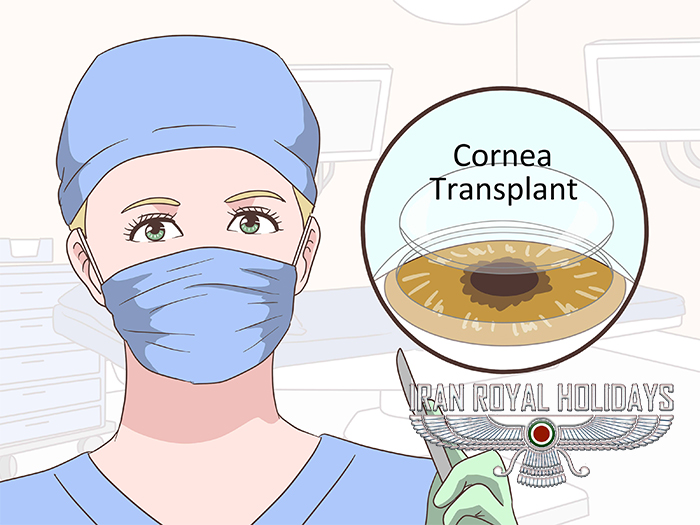Corneal transplantation and Glaucoma treatment in Iran
Corneal transplantation
Corneal transplant surgery, also known as keratoplasty, is one of the most common surgeries in Iran. This procedure is to replace the damaged or diseased cornea with donated corneal tissue. We are proud to announce that the success rate of corneal transplant surgery in Iran is very high due to very skilled and capable ophthalmologists. The cornea is essential for vision, for protecting the pupil, and for concentrating light waves.

That is why corneal transplantation is necessary in the following cases:
- Corneal ulcers due to injury or infection
- Corneal ulcers
- Keratoconus (keratoconus)
- Corneal swelling
- Hereditary eye diseases
- Problems from previous surgeries
Surgery: As with any surgery, you should refrain from taking aspirin for weeks before surgery to reduce bleeding. To prevent infection, you should take antibiotic drops the day before the transplant.
The surgeon removes part or all of the diseased or damaged part of the cornea, and replaces it with healthy donated tissue. Donated tissue is removed from people who have voluntarily requested a corneal donation after death. Corneal transplant surgery is usually performed on an outpatient basis under local anesthesia, and usually takes between 30 minutes and 1 hour.
After the operation: It is necessary to wear blindfolds for 14 days. Itching and pain are normal for a few days after surgery. You will be prescribed eye drops to reduce inflammation and reduce the chance of infection. Painkillers are also prescribed to reduce pain. You also need to change your lenses or glasses.
A full recovery may take up to a year, but you can return to work within a few weeks of surgery. For the first 2 weeks after surgery, strenuous exercise is prohibited. It is worth noting that the cornea will be donated for life.
Glaucoma treatment in Iran
Glaucoma is damage to the optic nerve, and can cause blindness that is irreversible.
The people at risk for glaucoma are:
- Specific breeds such as African-Americans, Irish, Russians, Japanese, Hispanics, Nordic Canadians, and parts of Greenland and Alaska;
- People over 40,
- People with a history of glaucoma,
- People with diabetes,
- People with ocular trauma.
There are several ways to treat glaucoma, including the following:
Medication: The most common initial treatment for glaucoma is the use of pills and eye drops that can lower eye pressure and dry out the eye fluid.
Laser: This procedure may be prescribed by your surgeon at any time to help dry eye fluid. Anesthetic eye drops are injected into your eyes before laser treatment at your doctor’s office or clinic. The laser causes multiple burns that drain the fluid better. If both eyes need laser treatment, treatment is scheduled for a few weeks after the first eye heals.
Surgery: Surgery is recommended if medication to control pressure on the eye is not effective. In this procedure, your surgeon makes small injections around the eyes to numb the eyes, and then uses a surgical instrument to make a small hole in the opening. This surgery is outpatient and is performed under local anesthesia.
After surgery: You should avoid water contact with your eyes for at least 2 weeks after surgery. You should also avoid reading, driving, bending, and lifting heavy objects. Excessive tears, redness, and itching after surgery are normal. You may also need to change your lenses or glasses. Special care is needed to prevent infection.
The type of treatment depends on the type and degree of glaucoma, as well as the general health of the eye. It should be noted that surgery cannot restore vision. It is also worth noting that immediate treatment of glaucoma in the early stages can prevent the progression of the disease.
It should be noted that surgery cannot restore lost vision. It is also worth noting that immediate treatment in the early stages of glaucoma can prevent the disease from progressing.

Comments are closed here.